Modern sensitivities towards the materials used in historic items may sometimes distract from their significance. This is often highlighted in the antique textiles industry with embellishments of real fur or whalebone lining found within corsets. However, the relic of a costume could not be discounted for its use of these elements, as they are important in telling the story of the era in which it was created. The fur, an example of fashion and common sensitivities of the year it was created. The whalebone lining, a prime example of a by-product from the whaling trade, which defined the globalisation and industrial changes of the time.
 Above: a selection of ivory items including a rosary terminal bead, a netsuke of Okame, a box in the shape of a duck, a netsuke with colourful bird decoration, an edo period netsuke figurine, an 11th century casket, a Roman ivory statuette of a reclining woman, a netsuke dog, and a netsuke featuring a man and an octopus
Above: a selection of ivory items including a rosary terminal bead, a netsuke of Okame, a box in the shape of a duck, a netsuke with colourful bird decoration, an edo period netsuke figurine, an 11th century casket, a Roman ivory statuette of a reclining woman, a netsuke dog, and a netsuke featuring a man and an octopus
Whilst ivory can be a contentious subject, the collection of historic pieces protects the artistic and geographical history attached to them. Thus, the restoration of such artworks is just as important as that of an oil painting or sculpture.
 Above: a detail from an ivory plaque featuring the evangelists, 1000-1050 AD
Above: a detail from an ivory plaque featuring the evangelists, 1000-1050 AD
The use of ivory stretches as far back in time as antiquity, as before the production of plastic it was seen as the most durable and easily decorative alternative. Classical civilizations produced ivory ornaments in huge quantities, notably seen in Greek and Roman statues, where it was used to create the whites of the eyes. Asian history also saw the frequent use of ivory in both decorative and functional objects, with 17th century netsuke figurines and larger okimono ornaments still being a popular genre in the antique ivory market today.
 Above: a fragment of Byzantine ivory, 6th century
Above: a fragment of Byzantine ivory, 6th century
During the Art Deco era, ivory was included in the creation of chryselephantine statues and in recent history, it was used for piano keys until the 1970s. With this vast range of historic and societal importance, it is essential that in the modern-day we can both preserve and restore ivory objects.
 Above: a detail from an carved ivory box, 10th-11th century
Above: a detail from an carved ivory box, 10th-11th century
What is ivory?
Ivory can come from naturally and geographically diverse sources. These can be significant in terms of their historic context and connection to the type of object which has been created.
Whilst the most common idea of ivory is elephant tusks, it can also be taken from the walrus, hippopotamus, narwhal, sperm whale and even tropical palms which make a botanical variety.
 Above: a detail from a 13th century ivory diptych showing natural signs of aging
Above: a detail from a 13th century ivory diptych showing natural signs of aging
Ivory and bone ornaments can sometimes appear similar and face the same issues in decay. However, you can tell them apart due to weight (a bone piece will feel lighter) and visual impact (ivory is smooth, whilst bone may have small black holes). An expert can assess this if there is any doubt.
 Above: a detail from a 10th-11th century bone carving, you can see the small holes that indicate it is bone rather than ivory
Above: a detail from a 10th-11th century bone carving, you can see the small holes that indicate it is bone rather than ivory
How much is ivory worth?
Antique ivory auctions can include individual pieces which range from £100 to £200,000.
 Above: a close up of a valuable ivory netsuke carving, late 18th century
Above: a close up of a valuable ivory netsuke carving, late 18th century
Collectible Japanese netsuke figurines are the most highly prized. In 2016 a netsuke dog and puppy figurine sold for £221,000. In 2011 Bonhams had a world record-breaking Japanese auction in which netsuke ivory sold from £193,250 for the figurine of a stag, to £265,250 for the figurine of a shishi (lion dog).
 Above: a selection of edo period netsuke
Above: a selection of edo period netsuke
Whilst European ivory does not always reach the same prices as those from Asia, they are still valuable at auction. German ivory is one of the highest-selling, in 2009 an embellished ivory tankard sold for £20,000, in 2011 miniature ivory portraits of Roman emperors sold for £25,000.
Can I sell ivory?
Ivory is only allowed to be sold in the UK if it is of an antique nature, this means it must have been carved before 1947. This is also the case for restored ivory, where any new elements which include real ivory cannot have been added post-1947. Due to different international laws, it should not be attempted to sell outside of the UK without legal advice.
Only carved ivory can be sold, as any untouched ivory, such as complete elephant tusks, cannot be traded legally.
 Above: a selection of 18th century statuettes featuring carved ivory
Above: a selection of 18th century statuettes featuring carved ivory
How to restore broken ivory
Ivory can be seamlessly restored, in a similar way to ceramics or fine bone china. The conservator will first clean the object with a tailor-made solution to ensure it meets the needs of the piece and does not put it in any danger. The cracks can then be stabilised and broken pieces realigned with conservation grade bonding, which will allow for a smooth and invisible finish.

As contemporary ivory is an illegal material and the nature of these objects is to be carved in one piece, any missing parts are made from a synthetic version which is created to seamlessly match the original. Any missing areas can be professionally remoulded, giving both an aesthetic and physical stability to the work.
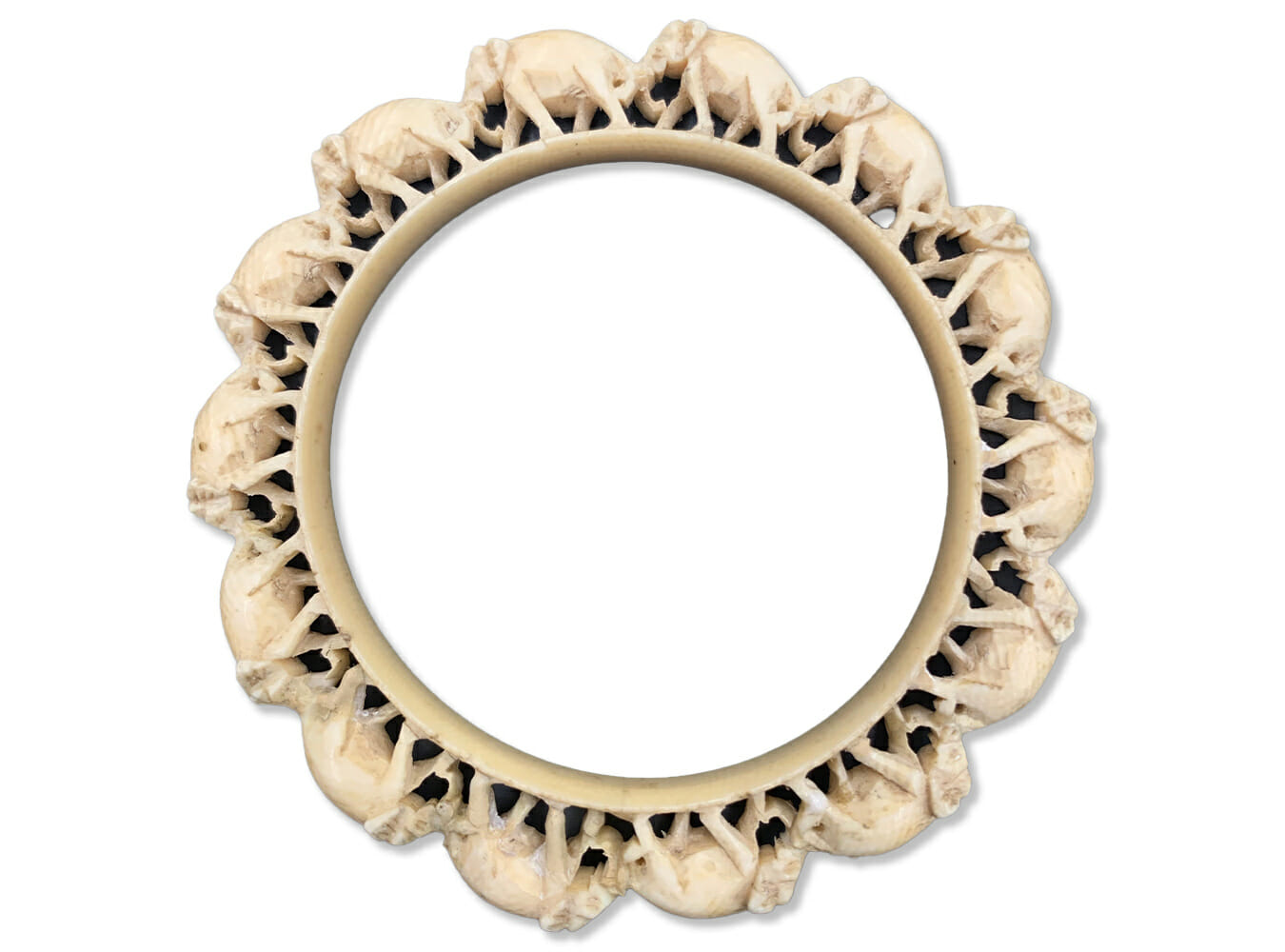
You can see the seamless reconstruction of a missing piece on this ornament of an elephant, where our conservator recreated a lost tusk for an invisible restoration.
How to preserve and display ivory
Ivory faces common problems which can affect a vast amount of artwork. Like many historic items, ivory is sensitive to moisture and humidity. As many important ivory pieces are small, a crack or split in the surface can appear catastrophic. From accidental damage to environmental instability, it is a natural substance which can decay faster if it is not diligently looked after.
 Above: a selection of ivory chess pieces from 1853
Above: a selection of ivory chess pieces from 1853
As an organic material, ivory grows in rings and also has a reliance on natural oils to stay stable. A lot of damage which may seem to occur spontaneously can be caused by the tension which exists innately, between the circular structure of the substance and the crafted variety of shapes it can appear in. When ivory is dry, it is more likely to split in these lines.
 Above: a detail of a 9th century ivory plaque with age related cracking across the surface
Above: a detail of a 9th century ivory plaque with age related cracking across the surface
Natural oils can be replicated at home to prevent the ivory from drying and facing any damage. Almond oil is recommended to treat the piece, this can be brushed on annually to reinvigorate the work. The oil should be brushed on to leave a shining residue on the surface, it can then be left overnight before being gently wiped away with cotton wool.
 Above: detail from an antique chest with decorative ivory inlay
Above: detail from an antique chest with decorative ivory inlay
Quick or constant changes in temperature and humidity can cause ivory to crack, so these elements should be kept at a good consistency. Humidity conditions should be kept evenly at around 50% and the temperature is advised to be around 22 degrees celsius.
 Above: details from an ivory bust from the late 17th century
Above: details from an ivory bust from the late 17th century
Like many antiques, UV rays from direct sunlight can affect ivory. You’ll see this noticeably with a piece which has been on display for a long time, with the front appearing as a bright white and the back, a darkened yellow. Constant sunlight will bleach ivory, whilst a dark location will cause it to yellow. When choosing a location to display an ivory piece, ensure that there is filtered light to prevent this from occurring. It should also be moved annually to ensure that all sides have an equal amount of exposure to the filtered sunlight.
 Above: a painted ivory plaque from the 16th century
Above: a painted ivory plaque from the 16th century
Popular ivory pieces are Japanese netsuke, which often have a pigment. Those with a lot of their original colour remaining are rare and highly valuable. When displaying this type of ivory ornament, ensure it does not touch a surface which could rub off the delicate historic paint. Displaying Japanese netsuke can be difficult due to their 3D nature, but many have specially pierced holes to allow for a cord which they are then traditionally suspended from.
If your ivory is placed on a surface, be vigilant that the fabric, wood or mount surrounding it is of a conservation grade and not likely to be acidic, as many modern materials may be. Seek expert advice when choosing display materials.
If you have any queries about the restoration of ivory objects, please get in touch.

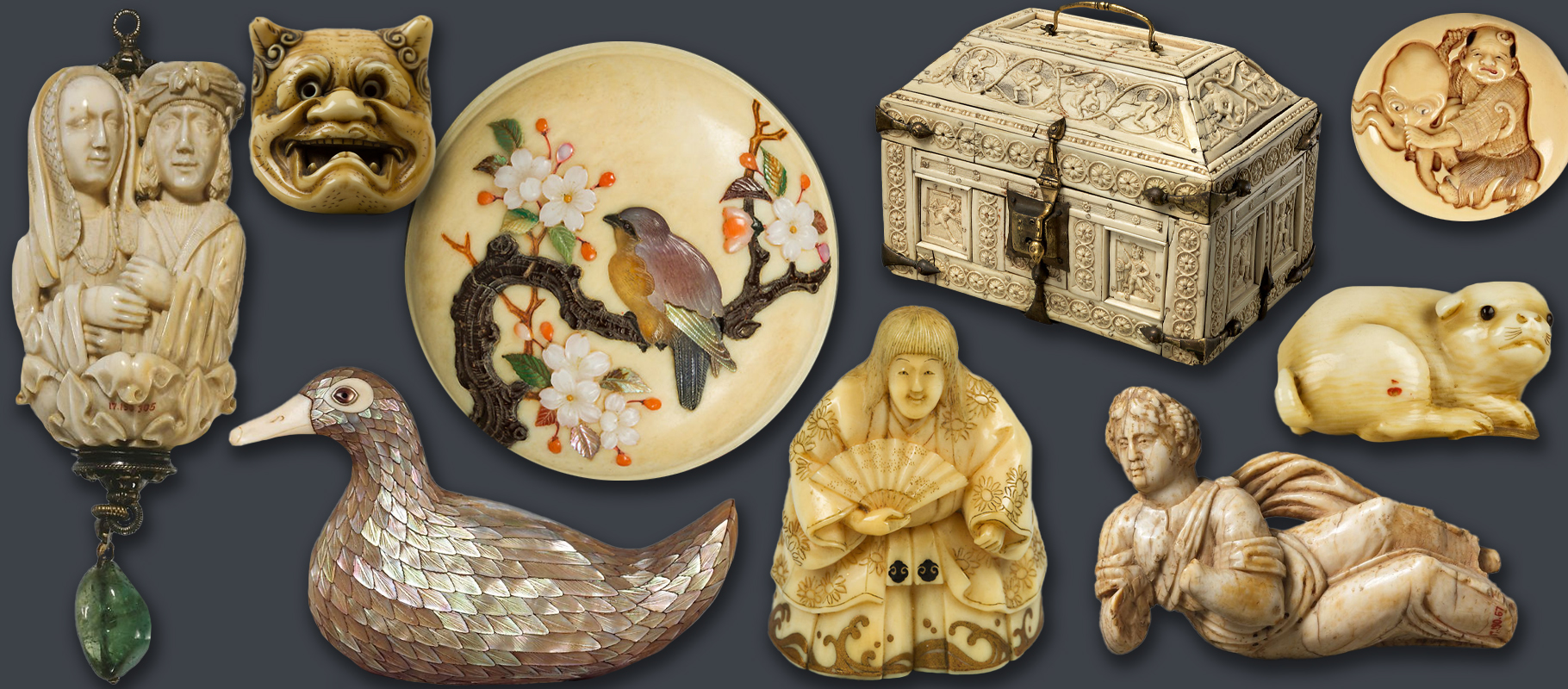 Above: a selection of ivory items including a rosary terminal bead, a netsuke of Okame, a box in the shape of a duck, a netsuke with colourful bird decoration, an edo period netsuke figurine, an 11th century casket, a Roman ivory statuette of a reclining woman, a netsuke dog, and a netsuke featuring a man and an octopus
Above: a selection of ivory items including a rosary terminal bead, a netsuke of Okame, a box in the shape of a duck, a netsuke with colourful bird decoration, an edo period netsuke figurine, an 11th century casket, a Roman ivory statuette of a reclining woman, a netsuke dog, and a netsuke featuring a man and an octopus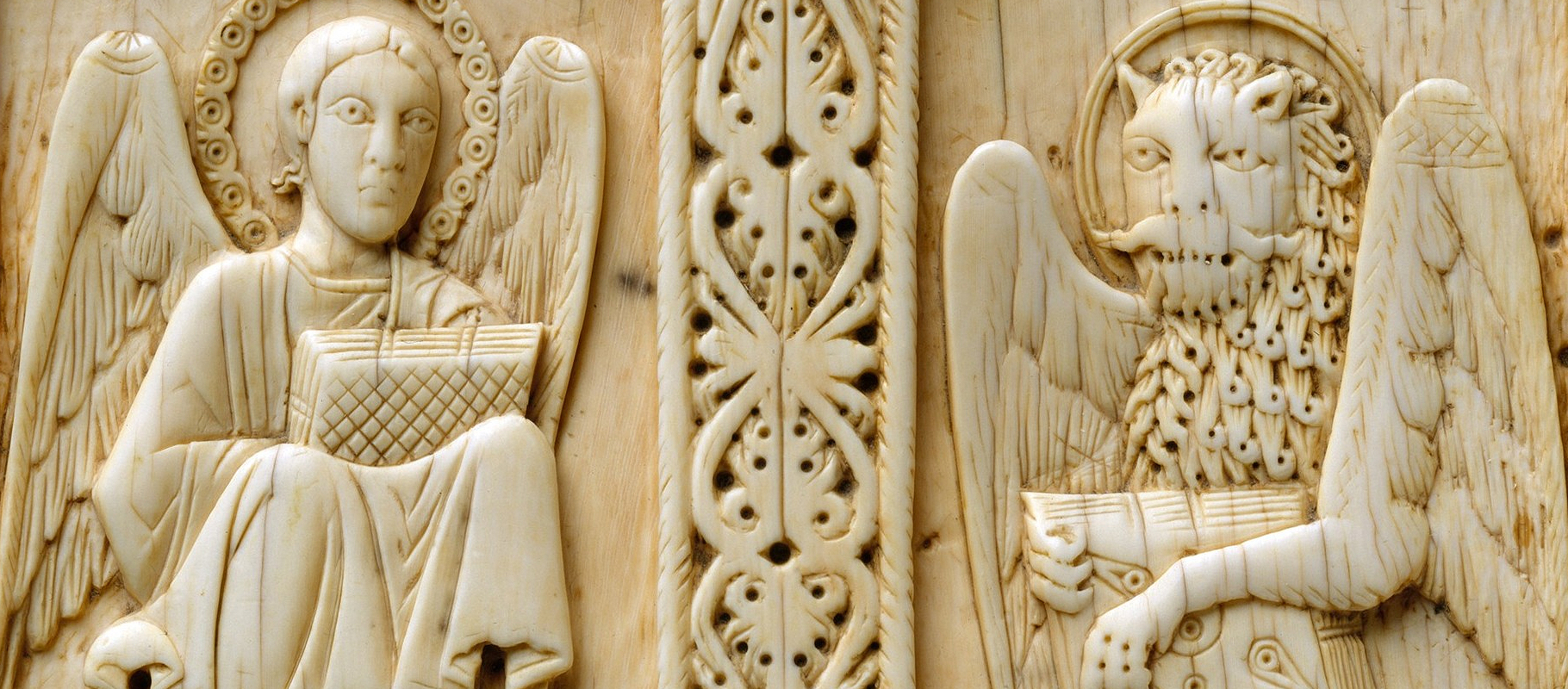 Above: a detail from an ivory plaque featuring the evangelists, 1000-1050 AD
Above: a detail from an ivory plaque featuring the evangelists, 1000-1050 AD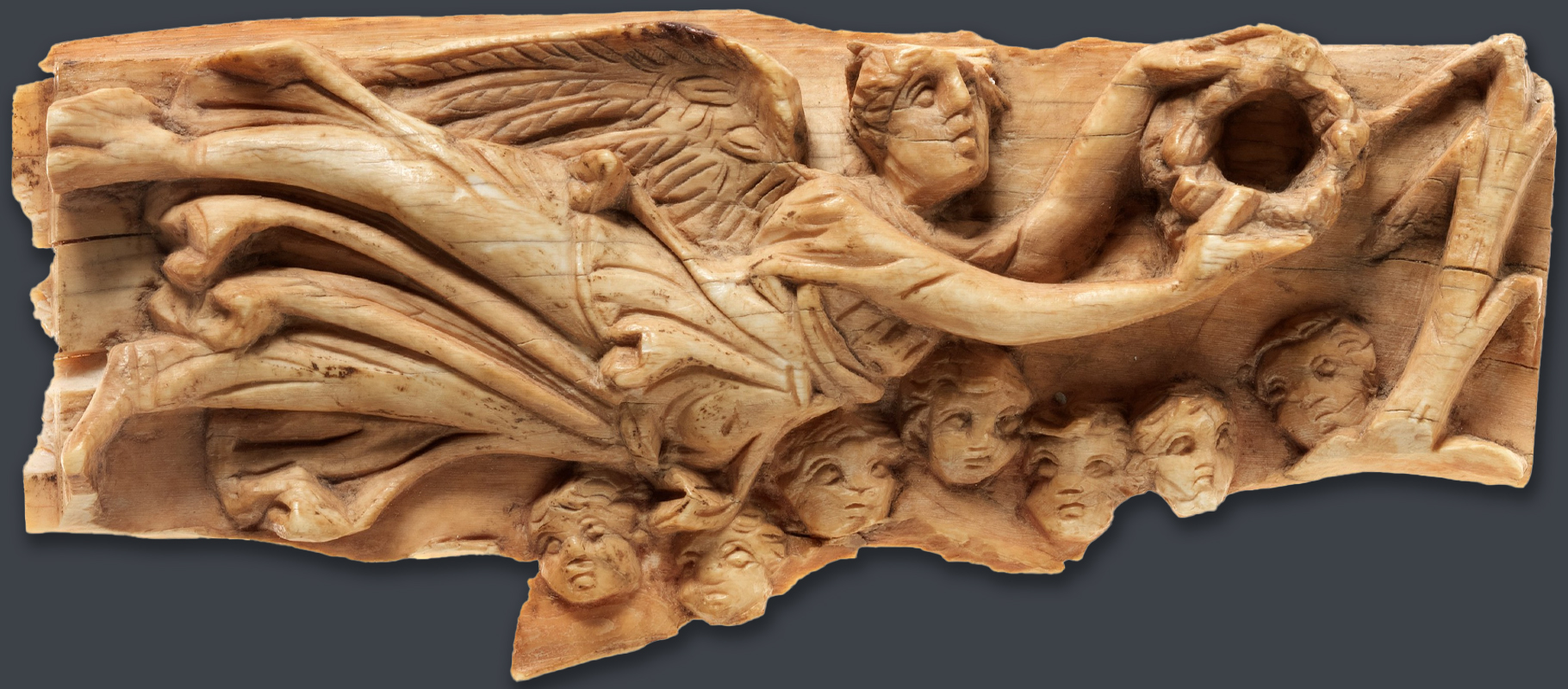 Above: a fragment of Byzantine ivory, 6th century
Above: a fragment of Byzantine ivory, 6th century Above: a detail from an carved ivory box, 10th-11th century
Above: a detail from an carved ivory box, 10th-11th century
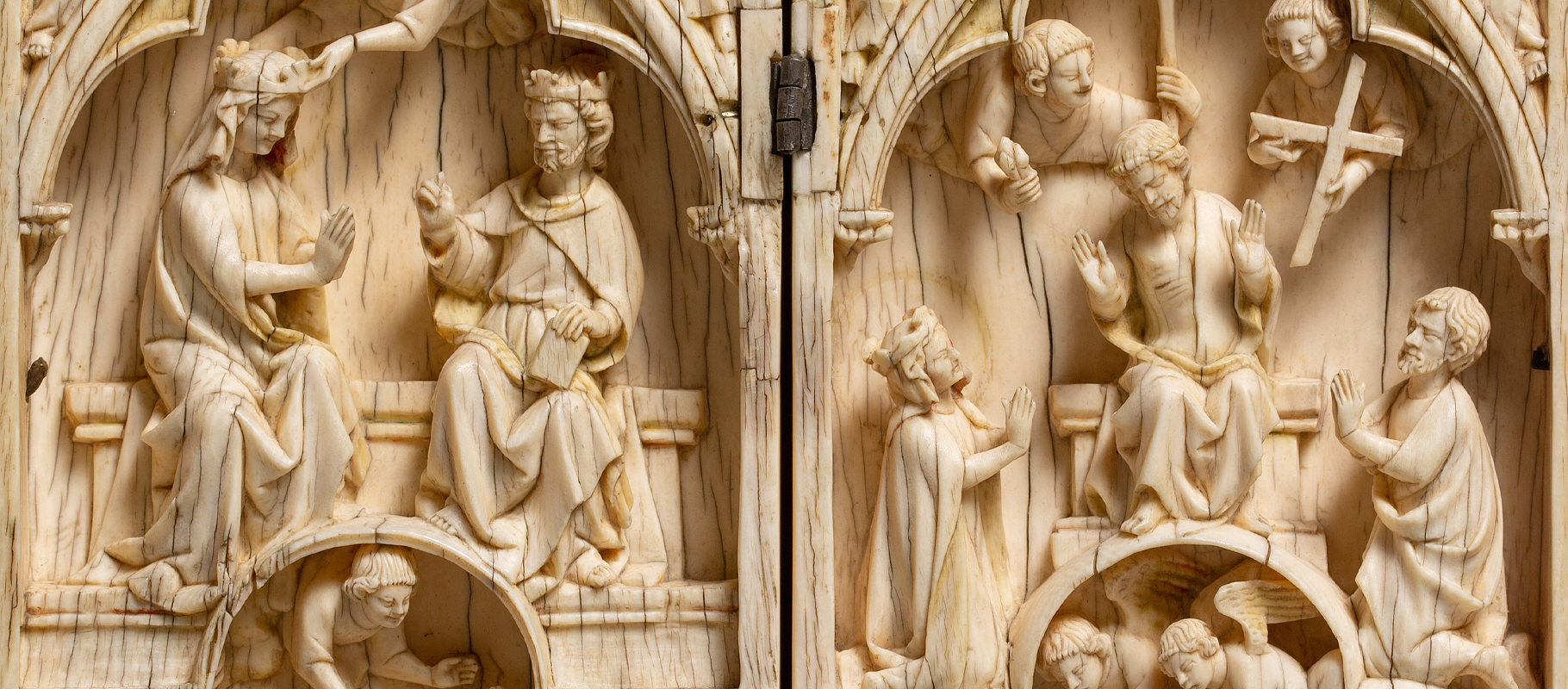 Above: a detail from a 13th century ivory diptych showing natural signs of aging
Above: a detail from a 13th century ivory diptych showing natural signs of aging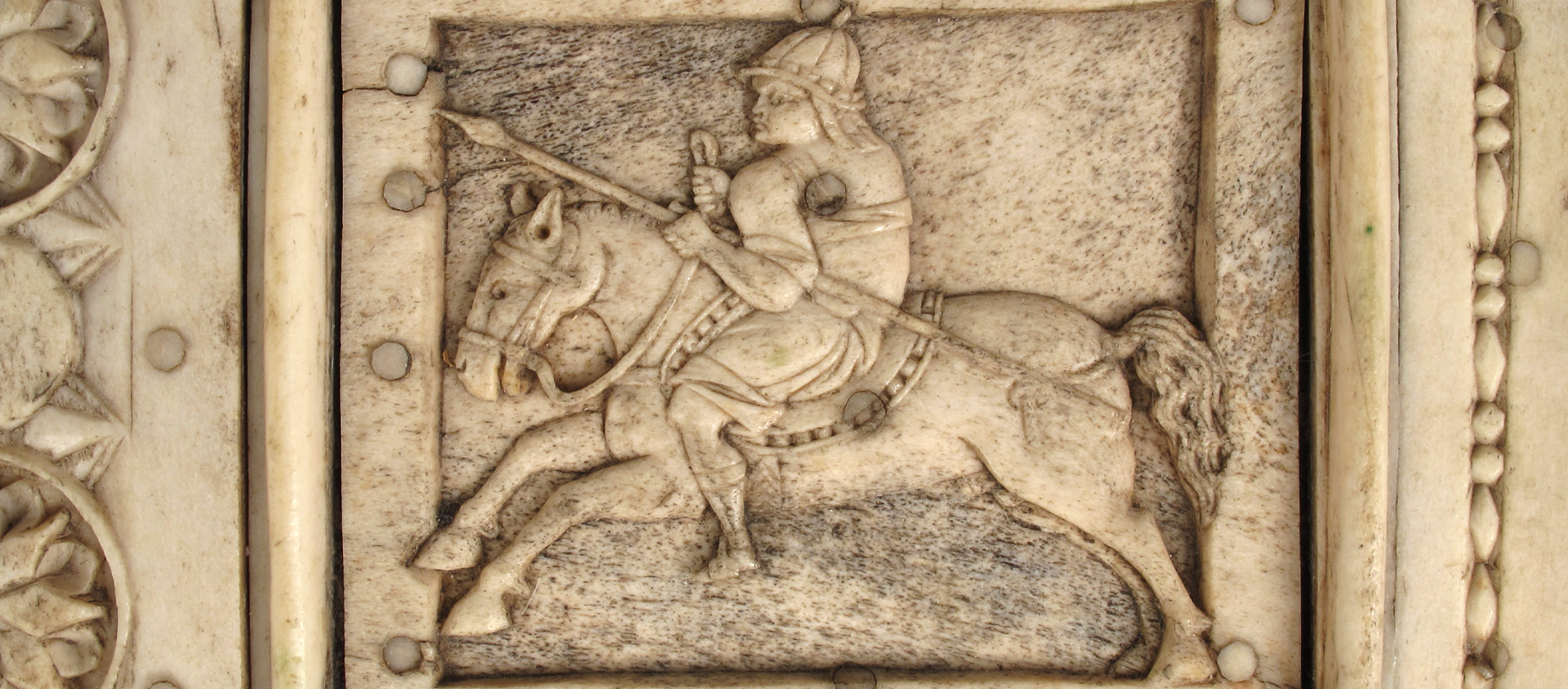 Above: a detail from a 10th-11th century bone carving, you can see the small holes that indicate it is bone rather than ivory
Above: a detail from a 10th-11th century bone carving, you can see the small holes that indicate it is bone rather than ivory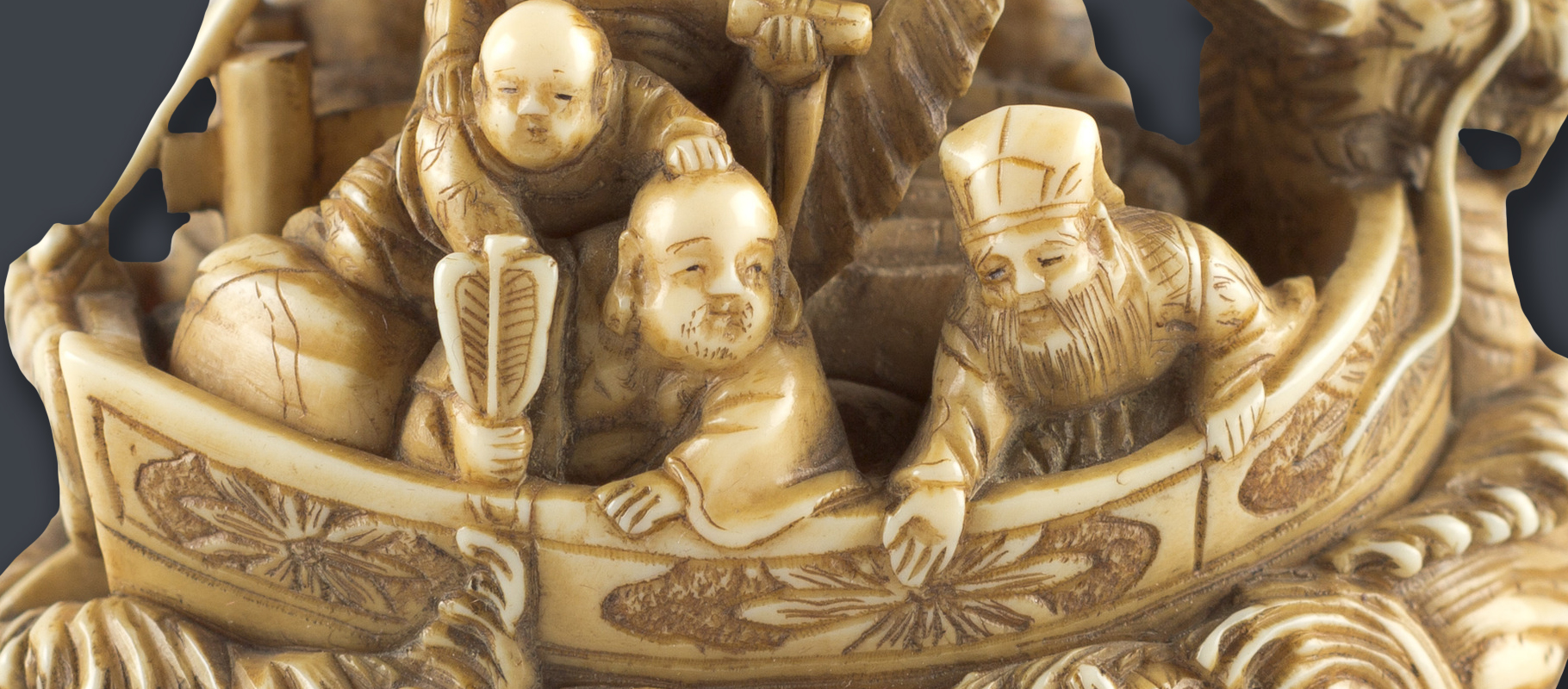 Above: a close up of a valuable ivory netsuke carving, late 18th century
Above: a close up of a valuable ivory netsuke carving, late 18th century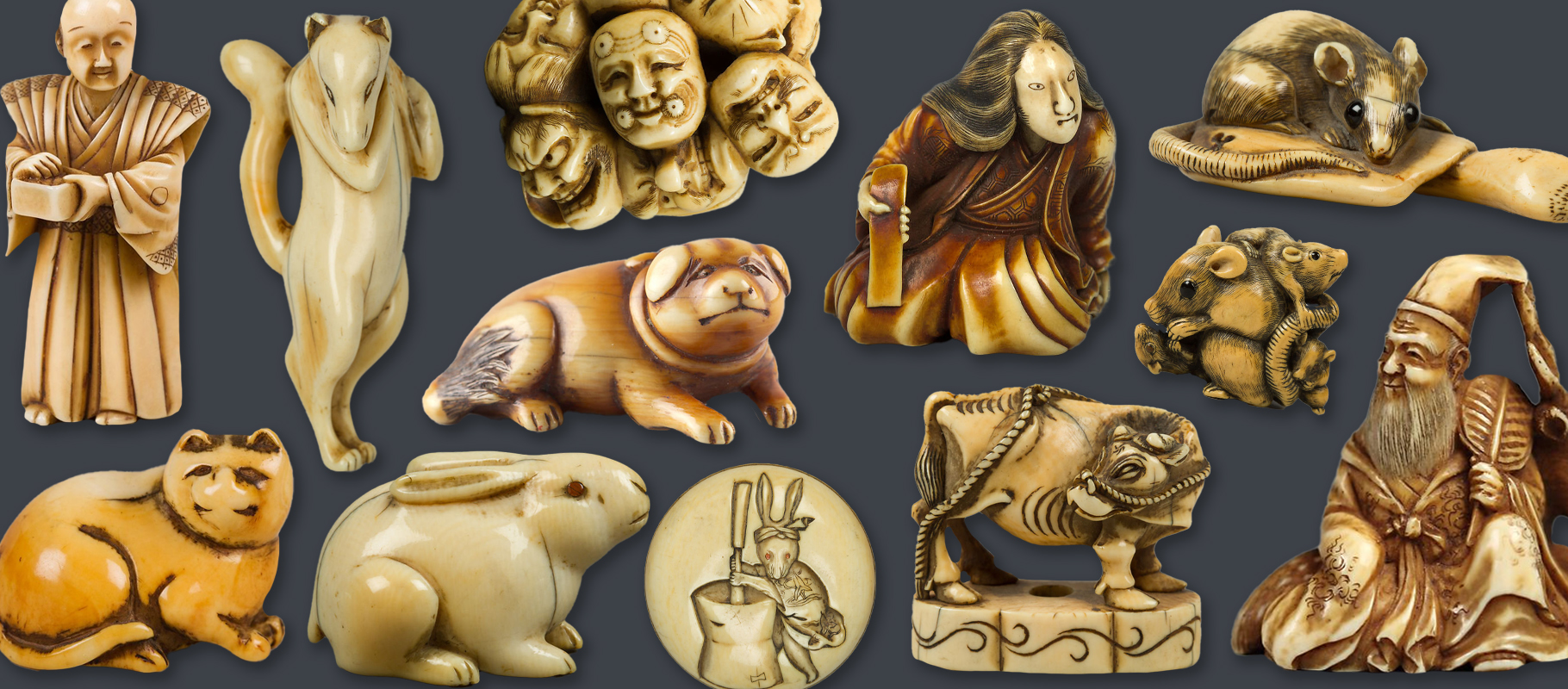 Above: a selection of edo period netsuke
Above: a selection of edo period netsuke Above: a selection of 18th century statuettes featuring carved ivory
Above: a selection of 18th century statuettes featuring carved ivory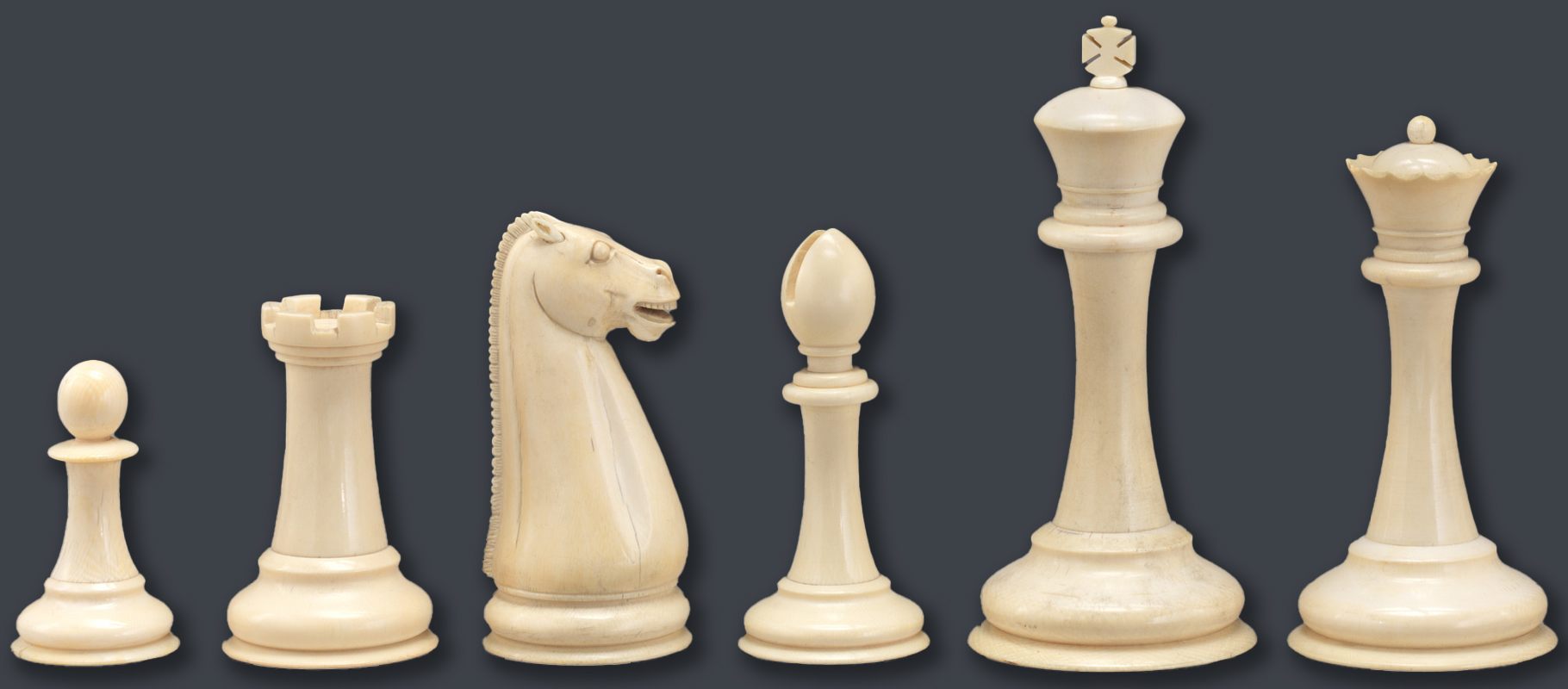 Above: a selection of ivory chess pieces from 1853
Above: a selection of ivory chess pieces from 1853 Above: a detail of a 9th century ivory plaque with age related cracking across the surface
Above: a detail of a 9th century ivory plaque with age related cracking across the surface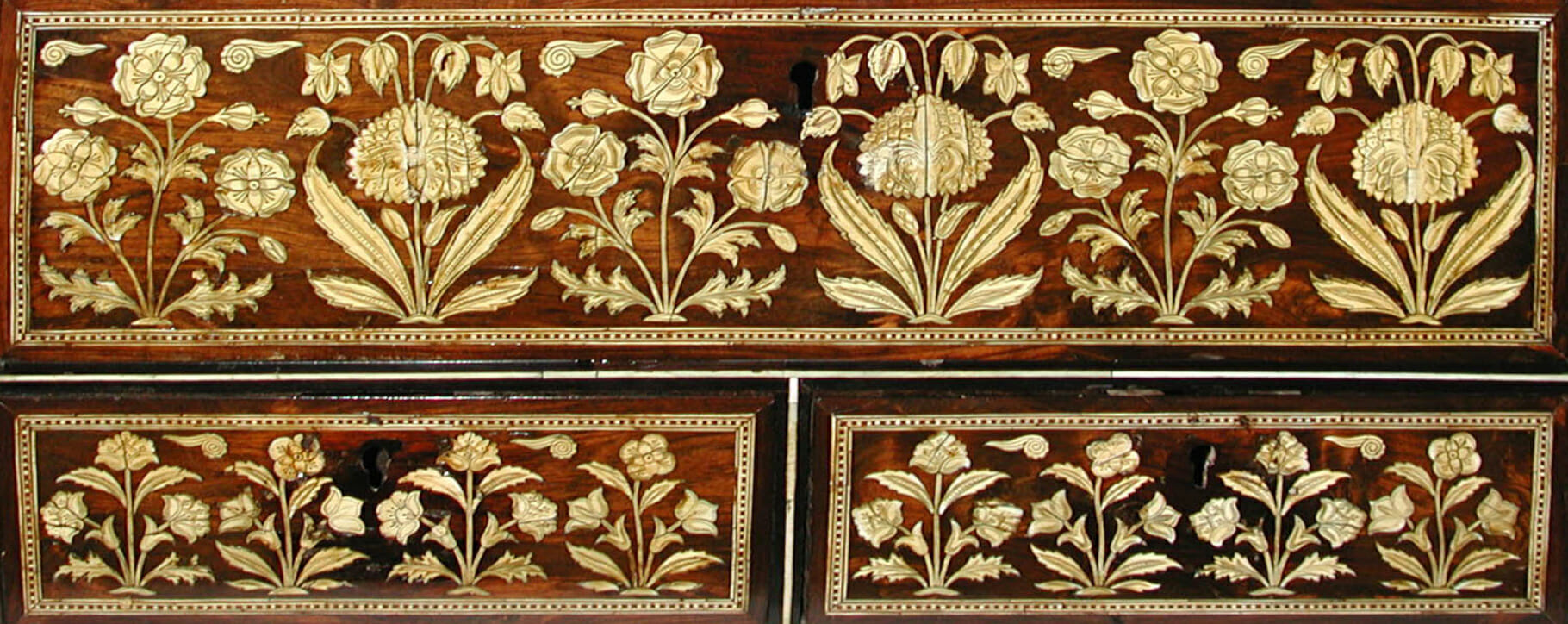 Above: detail from an antique chest with decorative ivory inlay
Above: detail from an antique chest with decorative ivory inlay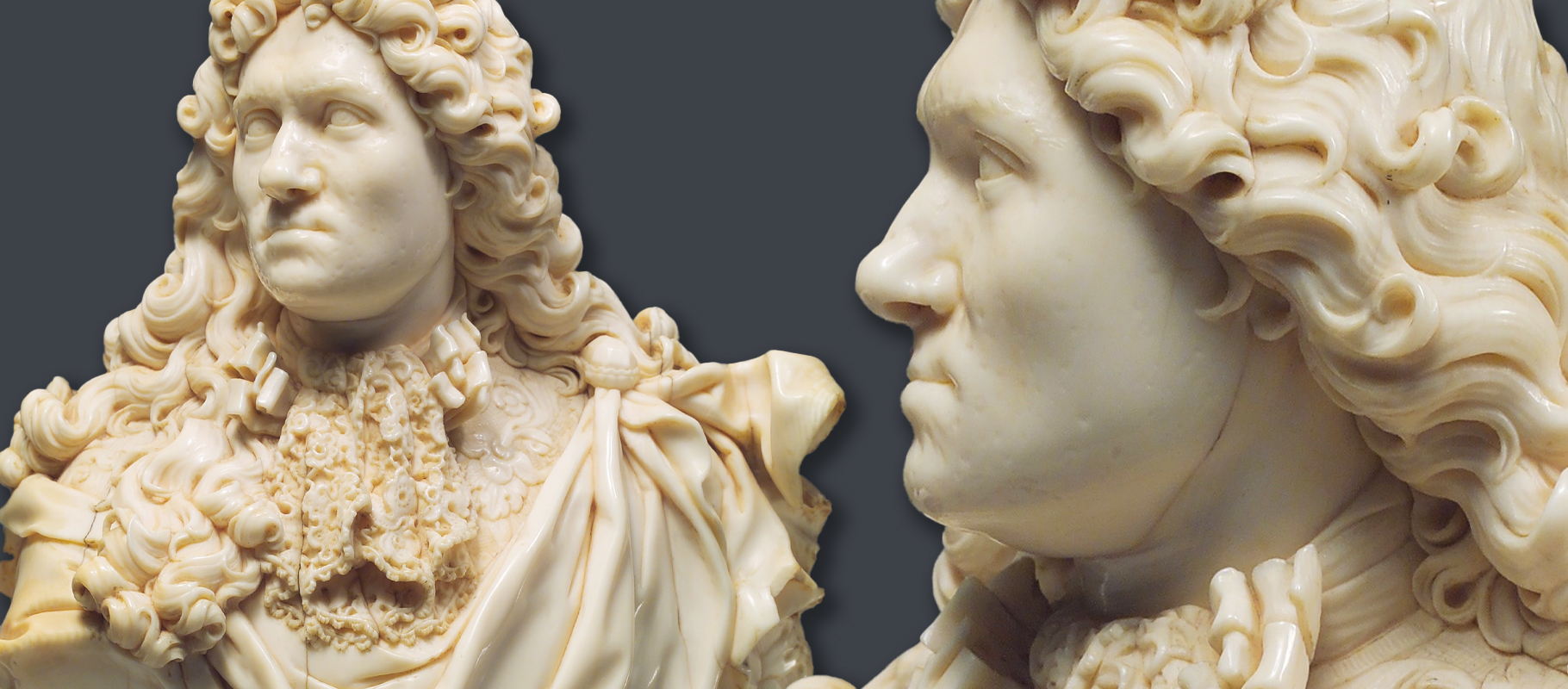 Above: details from an ivory bust from the late 17th century
Above: details from an ivory bust from the late 17th century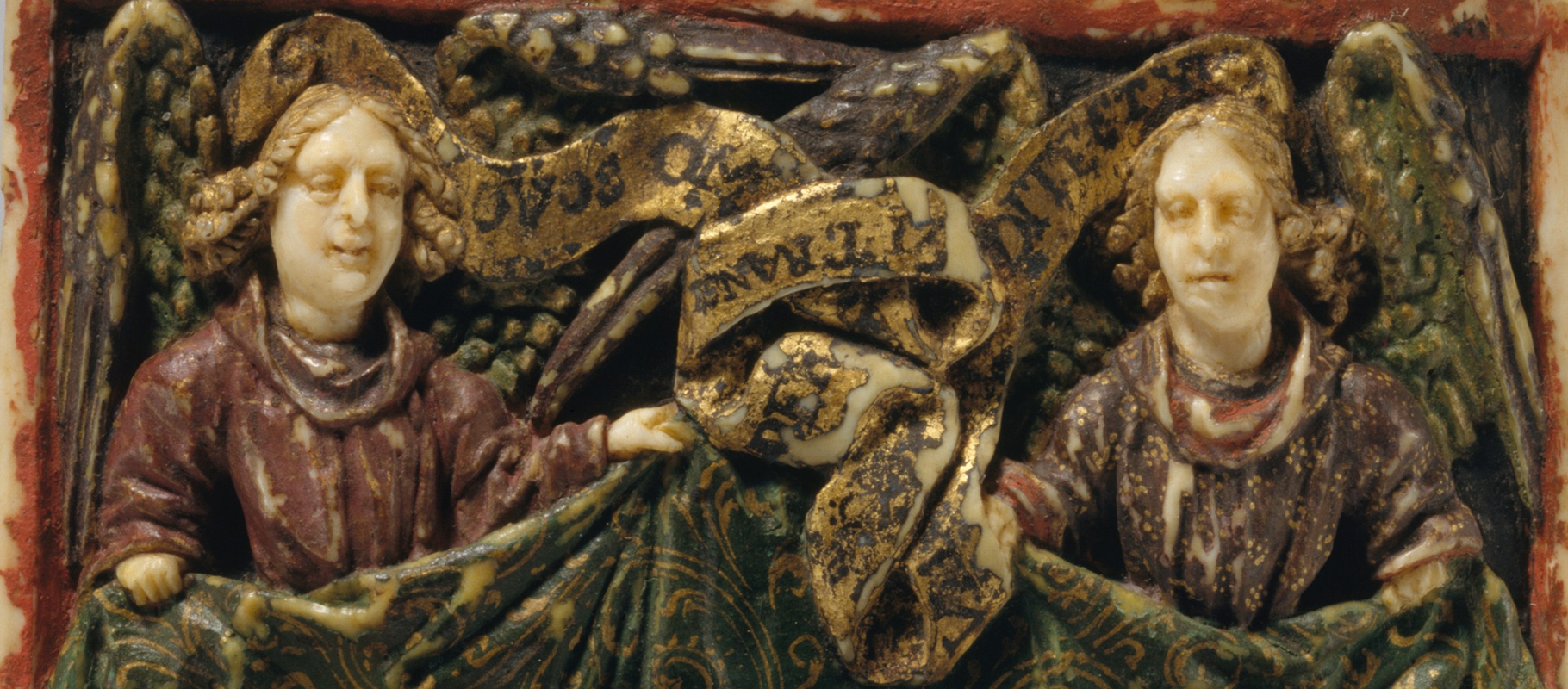 Above: a painted ivory plaque from the 16th century
Above: a painted ivory plaque from the 16th century




